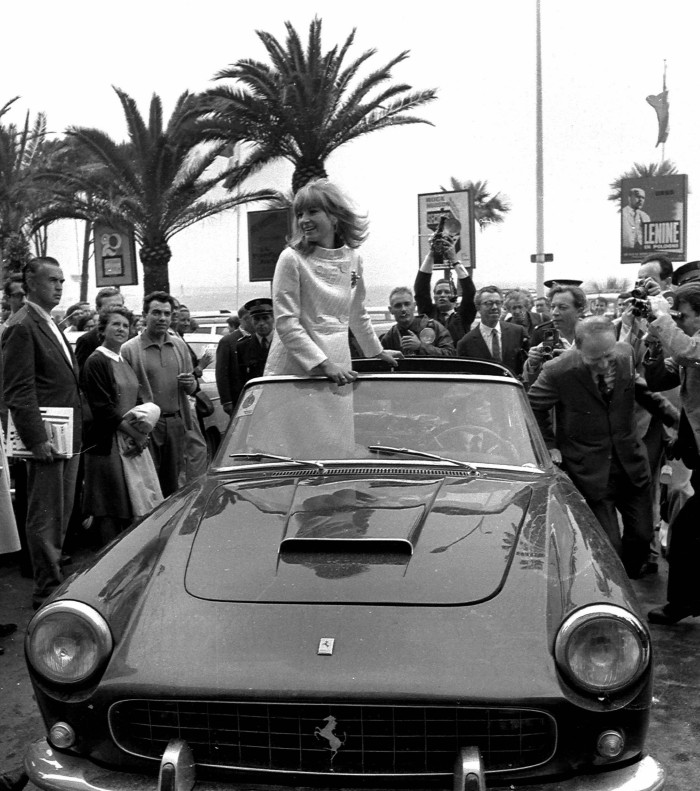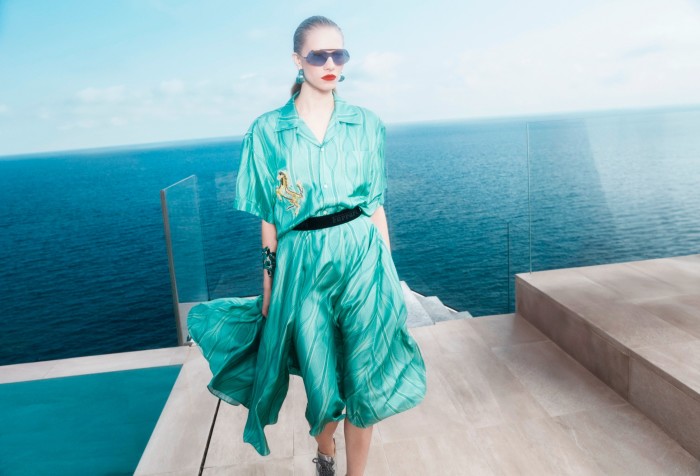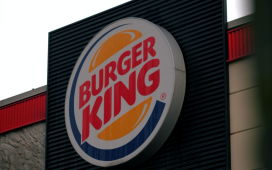When legendary Fiat boss Sergio Marchionne predicted that Ferrari would turn into a “luxury brand beyond the cars sector” in 2015, the Italian sports-car maker was yet to be spun off from its parent company and transformed into a $76bn business.
Almost a decade on, the Modena-based company controlled by the billionaire Agnelli family has broken into the ranks of high fashion with its seventh collection unveiled in February at Milan Fashion Week.
It featured dresses, skirts and capes in silk and organza in white and the brand’s staple red and yellow palettes, as well as accessories including sunglasses that cost €950 and small handbags that sell for more than €1,000.
“For us it is important because we have to nurture the next generation of Ferraristi,” chief executive Benedetto Vigna told the Financial Times.
“There will be people that can afford to [spend] €300,000-€500,000 on a car, and there are people that instead want to be attached to the brand, [through] something that is elegant, not a merchandise look.”
Ferrari’s merchandise prices have also increased significantly, said Vigna, with caps that once sold for €8 now priced at €80. Logo-emblazoned puffer jackets, with a retail price below €200, and hoodies are also popular among younger Ferrari fans.
An increasing number of luxury brands have sought to diversify their products in a bid to target a broader range of consumers and capitalise on their brand equity. Jeweller Bulgari recently appointed its first-ever creative director for accessories, while Fendi and Dolce & Gabbana have ventured into home decor, and other fashion houses, including Chanel, Armani and Prada, have launched skiwear lines.
But brands usually stay within the same or similar sectors — although Bugatti and Porsche have launched small collections of apparel, Ferrari is the only carmaker to have made the leap from engineering and sports clothing into top-end luxury fashion.
“The luxury sector is a single competitive arena, we all fight for the same discretionary spender,” said Ferrari’s chief brand officer Maria Carla Liuni. “The personal luxury goods market is the most interesting for us . . . Ferrari has hundreds of millions of fans around the world and we are settling on a 1 per cent slice.”

Before launching its high-fashion line three years ago, the 85-year-old car company had partnered with a range of retailers to sell a variety of branded merchandise including apparel, shampoo and perfumes.
In 2019 the group decided to bring back merchandising design in-house. Creative director Rocco Iannone, who previously worked for Armani and Dolce & Gabbana, joined to launch Ferrari’s high-fashion line and spent two years studying the brand’s identity and heritage to come up with his first collection.
Iannone’s first collection debuted during the pandemic in 2021 with an evocative fashion show hosted by chair John Elkann — who wore a vintage Ferrari-printed red silk shirt — at the car factory in Maranello. The designer said the collection was originally targeted at Gen Z and Asian customers but over the past two seasons there had been a qualitative shift in tailoring and materials.
“The point was to expand beyond Ferrari’s fan base,” Iannone told the FT. “The challenge was to create a narrative based on the brand’s history and heritage essentially starting from scratch and without actually having archives and a consolidated client base as creative directors normally do.”
Iannone said he ultimately drew inspiration from photographs of Italian cinema icons such as Anna Magnani and Monica Vitti driving Ferrari cars in the 1960s.

Analysts, however, have been sceptical about the venture’s financial success. “In my view it remains an uphill battle,” said Luca Solca, head of global luxury goods at Bernstein.
“One of the issues is that when a brand that sells products at a very high average price, as do Ferrari, Porsche or Bugatti, it’s hard to succeed in product categories with much lower average prices without giving the impression you are selling a gadget or giving away products.”
Several other analysts, who spoke on condition of anonymity, questioned the lack of financial disclosures on the fashion line. “The fact they don’t offer financial details makes us think the fashion line isn’t going so well, or at the very least not as well as Ferrari had anticipated when it launched,” said one.
Luxury retailers face an increasingly challenging market with the fortunes of groups diverging as the sector experiences a lower growth phase.
Vigna, however, insisted Ferrari was able to attract talent from other important fashion brands “because they believe in the project”.
Its foray into fashion is on top of a car business that is breaking records. On four occasions last year the company upgraded its own annual profit forecasts, as customers poured ever-higher sums into personalising their sports cars.
Net profit hit €1.26bn last year, with margins above every other car manufacturer, as it commanded higher prices and increased car sales to 13,663.
Vigna declined to speculate whether clothing would one day sit alongside cars as a major financial pillar of the business. But, after arriving in 2021, he focused on rejuvenating a clothing division that had become “more of a place to park people that were not good [at making] cars”.
Ferrari’s apparel offering has evolved through the years and its affordable sports merchandise and high-fashion lines now coexist. The company’s management argues that the 2015 stock market debut in New York at $52 per share showed that Ferrari is a luxury label rather than simply a sports car one, given that its shares currently trade at more than $400.

Liuni said the “story is as important as the product” and Ferrari had worked on finding a common thread between being an exclusive brand for the ultra rich and an inclusive one for all Formula One fans.
Since joining the company in 2022 Liuni has overhauled the team by poaching professionals from competitors in the luxury fashion sector and boosted investment in the fashion line. Beyond its revamped Italian flagship stores, the label is also planning new openings in London next year and in New York in 2026.
“We just presented management with a five- to eight-year plan . . . we are just at the beginning of this revolution,” she said. “But if there were a lack of demand we wouldn’t be part of the game.”
But Bernstein’s Solca said Ferrari had yet to “find the key” to make its push into fashion “credible”.
For example, he said, “highly sophisticated and luxurious tracksuits might have worked well” but by taking away the “performance element” from its luxury apparel offering, Ferrari also removed the obvious connection between its brand and the fashion sector.
“Jeweller Bulgari has branched out into handbags by using its flagship snake logo in its buckles, Tiffany has launched cafés by evoking the ‘Breakfast at Tiffany’s theme’, but how do you connect Ferrari and high fashion?”




